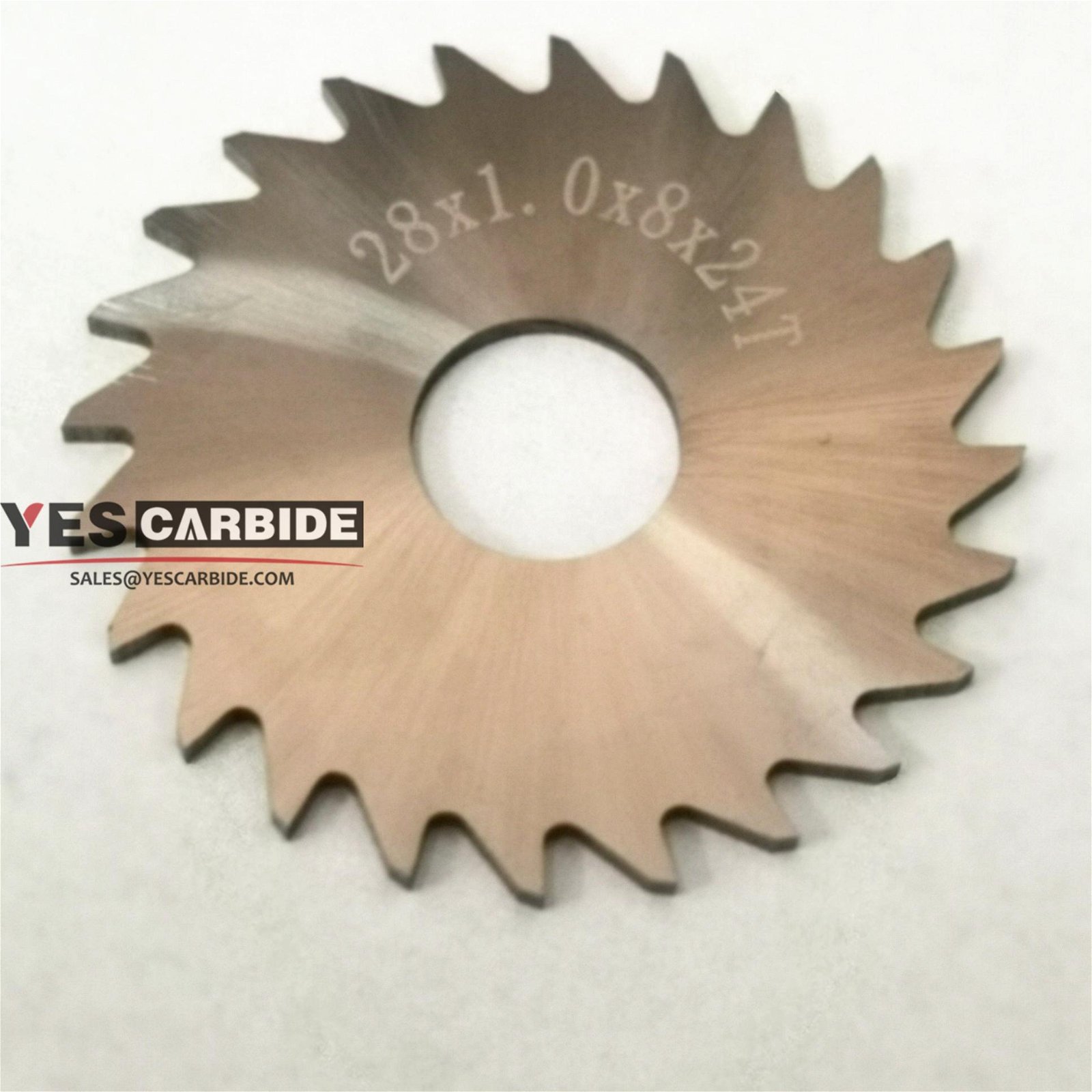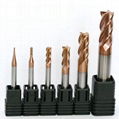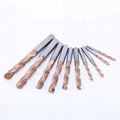| Model: | 28x1x8x24T |
|---|---|
| Brand: | YESCC |
| Origin: | Made In China |
| Category: | Industrial Supplies / Machine Hardware / Cutter & Tongs |
| Label: | carbide saw blades , saw blade cutter , tungsten carbide |
| Price: |
US $5.5
/ piece
|
| Min. Order: | 50 piece |
Product Description
Circular Saw Blades
YES Carbide manufactures and distributes all kinds of circular saw blades from 1" to 108" diameter. Standard / stock blades, mostly 24" and under in diameter, have a 2-3 weeks lead time, while custom made blades take 3-4 weeks. Contact us to place an order or to ask for assistance with the blade selection process. Fill out the technical support request form, and we will respond ASAP.
Carbide Tipped Circular Saw Blades
- We use the best grades of carbide for blade life and cut quality, specific to your application
- Flat top grind (FTG) for speed and efficiency in the primary wood industry
- Alternate top bevel (ATB) tooth geometry for smooth cuts in secondary wood industry applications
- Triple chip grind (TCG) for long blade life in general purpose (GP) and non-ferrous (NF) cutting applications
- Variations in tooth geometry make carbide tipped blades the best options for most applications
- Cut plastics, melamine / composite laminates, solid surfaces, fiberglass, steel, and more
- Custom consultations for designing the right blade for your application
- We can make ANY blade you want, so contact us to customize
High Speed Steel (HSS) Saw Blades
- Slow-spinning blades, often called "cold saw blades"
- Hardened throughout, making large diameters especially brittle
- For Ferrous cutting applications (M-2 Steel / 63-65 RC Hardness / 500 SFPM Max)
- For Non-Ferrous cutting applications (M-2 Steel / 54-56 RC Hardness / 500 SFPM Max)
- Blade coatings available: TiN (mild steel), TiCN (hard steel), TiALN (stainless)
Segmental Saw Blades
- Slow-spinning blades for ferrous and non-ferrous cutting applications
- Mild steel body with hardened tooth segments
- 11" (275 mm) - 56" (1430 mm) diameters available
- Segments have 2-12 teeth each, so specify when ordering
Solid Carbide Saw Blades
- Small diameters (1"-12") for slotting, slitting, and cut-off applications
- Longer tool life and faster cutting compared to HSS blades
- Significantly higher cost up front, but tool life makes cost per cut better
Friction Saw Blades
- Mild steel throughout, but fast spinning to "melt" through steel
- Often called "hot saw blades"
- 3 Primary tooth styles for specific applications
- 12" (300 mm) up to 84" (2130 mm) diameter
Other Circular Saw Blades
- Circular Slitter Knives (as pictured)
- Carbide Tipped Groovers (thick bodies)
- Inserted Tooth Cut Off / Slasher Saws
- Multi-Piece Dado Sets / Custom Designed Tooling
- Contact us with the specifics of your application
Which Is the Best Circular Saw Blade for Various Projects
There are differences in the tooth designs of various blades, which does affect their functionality, but the primary consideration when buying a new saw blade is the number of teeth. In general, a blade with more teeth will cost more to buy, but it is not necessarily better. You will probably end up needing several different blades to cover all the project's cutting tasks.
A general rule of thumb is a blade with fewer teeth will cut wood faster than one with many teeth, but the quality of the cut will be rougher. When just rough-cutting wall studs or other structural lumber, a low-tooth-count blade is ideal. Your primary concern when making these saw cuts is just getting the piece to the proper length and making it square, which is a function of the saw quality, not the blade.
A saw blade with more teeth cuts slower, but the quality of the cut edge will be much smoother and cleaner. Even if you have plenty of time, you many not want to use a high-tooth-count blade. The slower cutting results in more heat buildup, so using this type of blade when it is not needed can result in burning the wood edges. When making fine-quality furniture and cabinetry, this can ruin the piece of wood.
The least number of teeth you will find on a circular saw blade is about 14. A circular saw blade is only 7-1/4 inches in diameter. Fourteen teeth are ideal for the rough cuts on 2x4 framing lumber, and they cut very fast. If you would attempt to use this type of saw blade to cut thin material, it would destroy the wood. It would also create an unacceptable cut on plywood.
A 24-tooth blade is a good compromise for many cutting jobs, and it is the most common blade supplied with new circular saws. It is, however, still considered a fairly low number of saw teeth. You will find this blade produces a reasonably smooth rip cut (along with the grain of the wood), but the crosscut (across the grain) will be quite rough.
If you are planning to do any cutting of plywood or plastics for your projects, select a blade with 40 or more teeth to minimize the amount of tear out on the wood surface. This blade also produces a fairly nice crosscut on solid lumber. For cutting high-quality veneered plywood and some plastics, use a blade with 60 or 80 teeth.
When fitting joints together, you will use a miter or cutoff saw. This is typically a larger diameter blade with more teeth. Most of the cutting done on this type of saw is crosscutting, so a blade with at least 80 teeth is advisable for clean edges.
What type of circular saw blade do you need to cut metal?
When using a circular saw, you need to be sure you're using the correct blade for the material you are cutting. Not only will you need a different blade for cutting metal than you would for cutting wood, but a metal-cutting blade should not be used in the same saw as the type used for wood. This is because a wood-cutting circular saw has an open motor housing. While a metal-cutting saw has a collection bin to prevent metal chips from getting into the machine, a woodcutting saw isn't designed this way. If you do decide to use a wood saw on metal, only use a 7 1/4-inch blade and preferably a worm drive blade, which provides extra torque. Be aware that while most saw blades should be installed with the label visible, worm-drives are mounted on the opposite side.
You'll need different blades for different kinds of metal. You should be able to use a carbide-tipped abrasive cutoff wheel for non-ferrous metals like brass, aluminum, copper or lead. Carbide-tipped blades last up to 10 times longer than regular steel ones. The pitch and design of the blade you choose will also vary depending on the thickness of the metal in question. In general, you'll want a higher tooth count for thinner metals and a lower tooth count for thicker ones. The packaging of the blade should specify what material and thickness the blade is appropriate for, and if you have any questions, you can always contact the manufacturer.
Most home improvement stores only carry circular saw blades for cutting wood, so you may have to search online or go to a specialty tool store. Don't choose your saw blade solely on price, or you might not be happy with the results. As always when purchasing a blade for your circular saw, make sure it has the right diameter and arbor size to match your saw.
WHY USE CIRCULAR SAW BLADES?
carbide-tipped saw blades provide a superior finish cut as well as:
- Better dimensional control
- Minimal blade vibration and noise
- Lower cost and material loss
- Higher feed rate without overfeed problems
- We have 10″ & 12″ sizes of all of our blades
- Smooth cuts for professional woodworking
Our exclusive variable-pitch, variable depth tooth design (VPD) eliminates the harmonic effect experienced with conventional saw blades and their singular pitch and tooth design. With YES CARBIDE VPD circular saw blades, you’re assured of blade strength, longevity and performance. Whether you need circular saw blades for wood cutting, finishing work or a variety of other jobs, there’s a YESCC® carbide-tipped saw blade suited to your requirements.
What is the difference between HSS and carbide tools?
High-speed steel (HSS) is the standard for metal cutting tools since the nineteen-thirties. It is often used as a starting point for comparison because of its toughness, wear resistance, and sufficient hardness for general purpose metal cutting, make them a solid baseline for comparison. High-Speed Steels have a typical rockwell hardness range of 62-64. Such tools are readily available, and cost-effective.
Advantages of carbide
The use of carbide in cutting tools began development in nineteen-twenty-five. Tungsten Carbide particles, which are much smaller than a grain of sand, are combined with a cobalt to create a solid mass. Cobalt acts as the binder to "cement" the particles together. This compound revolutionized the metal-cutting world by enabling faster speeds and feeds and providing longer tool life.
It also retains its hardness at higher temperatures than HSS, so it can be worked harder to cut faster.
Carbide tipped tools improve surface finish and hold its size far longer for better quality.
Although carbide tools are more costly, the overall cost is substantially less because only the thick cutting edge is carbide. The body and shank are made from less costly tough hardened tool steel.
Disadvantages of carbide
First, carbide is hard to sharpen. So, they are usually bought as inserts and replaced when they chip or wear down.
Second, although it can withstand compressive force very well, its tensile strength is very low. Carbide tips must always be at the axis of the lathe spindle. Moving the cutting point below the centerline can generate higher forces that will pull it apart.
| Payment Terms: | TT |
|---|---|
Member Information
| YES CARBIDE CO LTD | |
|---|---|
| Country/Region: | Hong Kong S.A.R |
| Business Nature: | Manufacturer |
| Phone: | 13185611205 |
| Contact: | NOVA JIANG (SALES MANAGER) |
| Last Online: | 11 May, 2020 |




